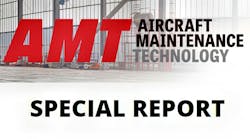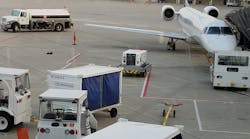How Will 2024 Federal Interest Rates Impact the GSE Market?
Since the COVID-19 pandemic, the aviation industry – including the ground support equipment (GSE) market – has continued to rebound.
According to data collected in Ground Support Worldwide’s annual State of the Industry survey, air travel’s ramp up since the pandemic has created more business opportunities for the majority of those polled. Only a slim margin of those polled reported being unable to keep up with current demand.
“Barring any significant correction in the industry, in the economy, it’s going to continue to move forward. I’m very bullish, if you will, on the industry going forward,” said Louis Sorrentino, CEO and managing director at aviation consultancy AvMaSSi.
With the industry moving in a positive direction and a potential decrease in interest rates, more investments among ground handling businesses could be on the way.
At the end of 2023, the Federal Reserve announced its intent to gradually lower interest rates from its current range of 5.25 to 5.5 percent to below 3 percent by December 2024.
Interest rates were previously raised in an effort to combat rising inflation. When interest rates are higher, it creates higher borrowing costs, which leads to less spending. And with less spending, demand for goods and services drops and inflation rates fall.
With the Fed’s plan to lower rates in 2024 and 2025, it can be surmised that consumer spending will pick back up.
However, it could take some time before the GSE market sees the same shift in spending, according to Jason Gendron, CEO at Mercury GSE, which specializes in servicing, renting, leasing and selling ground support equipment.
“Interest rates have a lag effect, with about a six-month lag, to what the Fed does. What we are seeing now is the effects of raises in interest rates that happened last summer,” Gendron said. “The effect of interest rates being lowered may not be seen in 2024.
“I think it is a wait-and-see approach for aviation,” he continued, adding he is not certain the U.S. economy has hit peak inflation, nor a peak in rates. “There has been a lot of purchasing that has happened post-COVID, and this is the year it may slow down.”
Higher interest rates drove up the costs of borrowing for those looking to purchase GSE. Manufacturers also endured higher costs as inflation increased. Gendron noted it can be difficult to retrace pricing once everyone becomes accustomed to higher prices for goods and services. As a result, he envisions more leasing could become the norm.
What Makes the GSE Market Unique
As lower interest rates tend to stimulate economic activity and make borrowing more affordable for businesses, Gendron pointed out that this could increase demand for GSE, support growth and create jobs.
“However, there are concerns that if interest rates are lowered too rapidly, or if economic conditions are already fragile, it may not be sufficient to counteract other negative factors that could contribute to a recession,” he said.
Because the GSE industry is tied to other sectors like commercial aviation and logistics, the impact of lowered interest rates may be tempered by the broader economic challenges these industries face, according to Gendron.
“Overall, while lower interest rates can be a tool to stimulate economic activity, it is crucial to carefully assess the specific economic conditions within the GSE space to gauge the likelihood of recession in our sector,” he said.
While the GSE industry is sensitive to changes in interest rates, Gendron noted there has been an increase in costs that may not go away immediately.
“The costs include labor, materials, parts, etc. It will take some time before those costs start to go down, thus affecting the GSE industry for the foreseeable future,” Gendron said.
“Additionally, the extent to which GSE providers rely on financing for their operations and the flexibility of end-users in adopting new equipment, or new ways of acquiring those assets can vary, shaping the industry’s response to changes in overall federal interest rates,” he added.
What’s more, replacement cycles for GSE can be driven more by factors other than short-term changes in interest rates. Gendron called out operational needs, technological advancements, breakdowns of GSE and regulatory requirements like electrification or emission mandates as considerations that might take priority when making purchasing decisions.
“This aspect provides a degree of stability in demand for GSE, which can mitigate the immediate impact of interest rate fluctuations,” Gendron said.
“Another factor that may offer some insulation from interest rate changes is the long-lived nature of GSE,” he continued. “Many of the businesses in the GSE sector engage in long-term planning, and their decisions to purchase or upgrade equipment are often based on strategic considerations, rather than short-term interest rate movements.”
Segments Sensitive to Fluctuation
Much of the GSE industry may be insulated, but individual segments of the market can be influenced by interest rates more than others.
Original equipment manufacturers (OEMs) and distributors, for example, can be more sensitive to these fluctuations due to the capital-related factors and supply chain dynamics.
“OEMs are at the forefront of GSE production, and their capital-intensive operations often rely on financing for research, development and manufacturing. When interest rates rise, the cost of borrowing increases, potentially affecting the profitability of EMS and their ability to invest in innovation and technology,” Gendron said.
“Additionally, distributors, who facilitate the supply chain between manufacturers and end-users, may face challenges. Higher interest rates can result in increased costs for maintaining inventory and managing working capital, potentially squeezing profit margins for distributors in the GSE space.”
So far in 2024, Mercury GSE officials have seen a downward trend toward purchases.
“It is hard to determine, yet, whether this is interest rate related or the overall economy,” Gendron said. “If interest rate changes influence the overall economic environment and the financial health of these end-users, it could affect their ability to invest in and upgrade their GSE fleets.
“However, the degree of impact on end-users may vary based on factors such as the financial health of the specific organizations, the critical nature of GSE for their operations and their ability to secure favorable financing or leasing/rental terms.”









